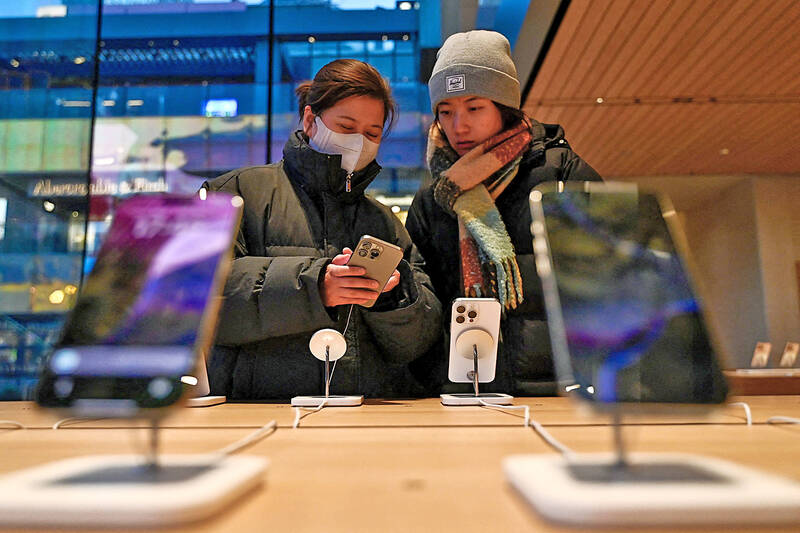Apple Inc was set to launch its latest budget iPhone model yesterday as it looks to grab a bigger share of the mid-range smartphone market and fend off competition from rivals such as Samsung Electronics Co and China’s Huawei Technologies Co (華為).
The fourth generation of the lower-cost model, so far known as iPhone SE, will take on popular Android smartphones at a time when consumer electronics makers are looking to add artificial intelligence (AI) tools into their devices.
The current generation of iPhone SE, released in 2022, is available at US$429 and the latest version is likely to be priced at a premium to the outgoing model. The iPhone 16, launched in September last year, starts at US$799 for the base variant.

Photo: Pedro Pardo, AFP
“If the SE 4 offers meaningful upgrades in design, performance, and AI features, it could reinvigorate its market appeal and strengthen Apple’s position across different price segments,” Counterpoint Research senior analyst Varun Mishra said.
Apple late last month forecast strong sales growth signaling that the company will recover from a dip in iPhone sales as it rolls out AI features in the coming months to more regions and languages.
However, analysts have been cautious about the sales boost such tools could provide, as Apple’s AI features are set to be rolled out in phases in some regions on its latest iPhone 16 line-up and the iPhone 15 Pro model.
The SE model’s sales as part of total revenue for iPhones has dropped from 10 percent from its introduction in 2016 to about 1 percent last year, according to Counterpoint Research.
This year’s update is expected to revamp its slab design, ditch the physical home button and introduce its FaceID feature, apart from camera and processor updates to support AI features, according to analysts and media reports.
The SE model would be the last among iPhones to adopt the USB Type-C port for charging, a departure from its proprietary Lightning connector.
Apple has already discontinued the current SE and iPhone 14 in the European Union as the products do not conform with local laws requiring USB Type-C charging standard. The latest SE model would let it return to the EU.

WEAKER ACTIVITY: The sharpest deterioration was seen in the electronics and optical components sector, with the production index falling 13.2 points to 44.5 Taiwan’s manufacturing sector last month contracted for a second consecutive month, with the purchasing managers’ index (PMI) slipping to 48, reflecting ongoing caution over trade uncertainties, the Chung-Hua Institution for Economic Research (CIER, 中華經濟研究院) said yesterday. The decline reflects growing caution among companies amid uncertainty surrounding US tariffs, semiconductor duties and automotive import levies, and it is also likely linked to fading front-loading activity, CIER president Lien Hsien-ming (連賢明) said. “Some clients have started shifting orders to Southeast Asian countries where tariff regimes are already clear,” Lien told a news conference. Firms across the supply chain are also lowering stock levels to mitigate

IN THE AIR: While most companies said they were committed to North American operations, some added that production and costs would depend on the outcome of a US trade probe Leading local contract electronics makers Wistron Corp (緯創), Quanta Computer Inc (廣達), Inventec Corp (英業達) and Compal Electronics Inc (仁寶) are to maintain their North American expansion plans, despite Washington’s 20 percent tariff on Taiwanese goods. Wistron said it has long maintained a presence in the US, while distributing production across Taiwan, North America, Southeast Asia and Europe. The company is in talks with customers to align capacity with their site preferences, a company official told the Taipei Times by telephone on Friday. The company is still in talks with clients over who would bear the tariff costs, with the outcome pending further

Six Taiwanese companies, including contract chipmaker Taiwan Semiconductor Manufacturing Co (TSMC, 台積電), made the 2025 Fortune Global 500 list of the world’s largest firms by revenue. In a report published by New York-based Fortune magazine on Tuesday, Hon Hai Precision Industry Co (鴻海精密), also known as Foxconn Technology Group (富士康科技集團), ranked highest among Taiwanese firms, placing 28th with revenue of US$213.69 billion. Up 60 spots from last year, TSMC rose to No. 126 with US$90.16 billion in revenue, followed by Quanta Computer Inc (廣達) at 348th, Pegatron Corp (和碩) at 461st, CPC Corp, Taiwan (台灣中油) at 494th and Wistron Corp (緯創) at

NEGOTIATIONS: Semiconductors play an outsized role in Taiwan’s industrial and economic development and are a major driver of the Taiwan-US trade imbalance With US President Donald Trump threatening to impose tariffs on semiconductors, Taiwan is expected to face a significant challenge, as information and communications technology (ICT) products account for more than 70 percent of its exports to the US, Chung-Hua Institution for Economic Research (CIER, 中華經濟研究院) president Lien Hsien-ming (連賢明) said on Friday. Compared with other countries, semiconductors play a disproportionately large role in Taiwan’s industrial and economic development, Lien said. As the sixth-largest contributor to the US trade deficit, Taiwan recorded a US$73.9 billion trade surplus with the US last year — up from US$47.8 billion in 2023 — driven by strong